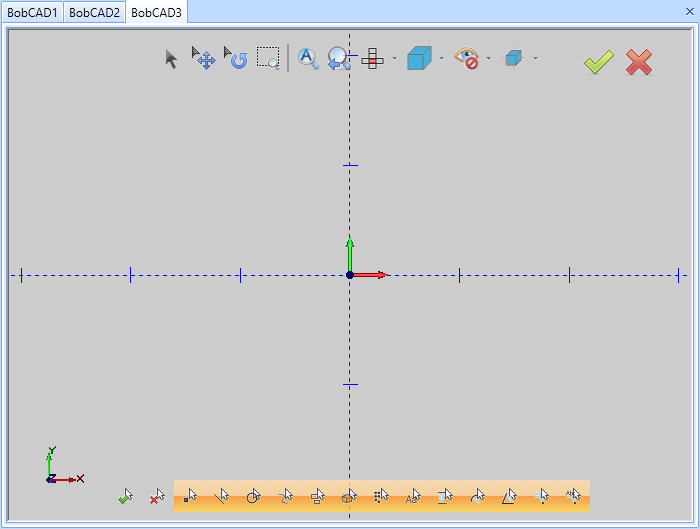The graphics area
Introduction
The graphics area, also known as the CAD window, is used to display any geometry that is created as well as any computed toolpaths. Each graphics area represents a file that is currently open. For each file that you open, there is a separate graphics area. By default, each graphics area has a tab at the top of the screen (in the Workbook), which you can click to view the selected graphics area.

The Document Toolbar
At the top of the graphics area, you will find the Document Toolbar. The Document Toolbar allows you to have the view options for the graphics area available to you no matter what ribbon is currently in use. For more information on the individual items in the document toolbar, see The Document Toolbar topic.
The Selection Mask Toolbar
At the bottom of the graphics area, you will find the Selection Mask Toolbar. The Selection Mask Toolbar is used to control what entity types can be selected in the graphics area. When you enable selection mode, you can click an icon to disable the ability to select that entity type. For more information on the individual items in the selection mask toolbar, see that section of The Home Ribbon topic.
The World Coordinate System (WCS)
In the bottom-left corner, the WCS (or world coordinate system)view indicator displays the positive directions of the X, Y, and Z axes. The WCS indicator is always in reference to the default Top (X/Y) UCS (selected in the UCS tab).
Note: The default Top (X/Y) UCS (user coordinate system) is the WCS when working in BobCAD-CAM. When this help system references the WCS, it is referring to the Top (X/Y) UCS.
User Coordinate System
The UCS (user coordinate system) indicator in the center of the graphics area indicates the origin and axes directions for the Active UCS or drawing plane.
The Graphics Area Shortcut Menu
Right-click anywhere in the graphics area to access the Graphics Area Shortcut Menu with many useful commands, as well as the Entity Summary.
Changing the View Orientation
With the Mouse
In order to become more proficient in working with your geometry, you should become proficient with your view of that geometry. One of the ways to do this, is to become familiar with the mouse controls.
With the Keyboard
Along with controlling the view with the mouse, it is also possible to control the view with the keyboard. The Keyboard Shortcut topic will list the keys, and key combinations used to control the view in the table found at the top of the topic. Examples of these motions are also provided in the topic.
Keyboard Shortcuts
There are many default Keyboard Shortcuts that can help you to work fast. Note that you need to click in the graphics area to give it key focus to use the commands.






